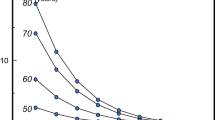Abstract
Bisphosphonates (BPs) are drugs widely used in the treatment of various bone diseases. BPs localize to bone mineral, and their concentration in resorption lacunae could reach almost milimolar levels. Bone alkaline phosphatase (ALP) is a membrane-bound exoenzyme that has been implicated in bone formation and mineralization. In this study, we investigated the possible direct effect of three N-containing BPs (alendronate, pamidronate, and zoledronate) on the specific activity of bone ALP obtained from an extract of UMR106 rat osteosarcoma cells. Enzymatic activity was measured by spectrophotometric detection of p-nitrophenol product and by in situ visualization of ALP bands after an electrophoresis on cellulose acetate gels. Because ALP is a metalloprotein that contains Zn2+ and Mg2+, both of which are necessary for catalytic function, we also evaluated the participation of these divalent cations in the possible effect of BPs on enzymatic activity. All BPs tested were found to dose-dependently inhibit spectrophotometrically measured ALP activity (93–42% of basal) at concentrations of BPs between 10−5 M and 10−4 M, the order of potency being zoledronate ≊ alendronate > pamidronate. However, coincubation with excess Zn2+ or Mg2+ completely abolished this inhibitory effect. Electrophoretic analysis rendered very similar results: namely a decrease in the enzymatic activity of the bone-ALP band by BPs and a reversion of this inhibition by divalent cations. This study shows that N-containing BPs directly inhibit bone-ALP activity, in a concentration range to which this exoenzyme is probably exposed in vivo. In addition, this inhibitory effect is most possibly the result of the chelation of Zn2+ and Mg2+ ions by BPs.
Similar content being viewed by others
References
M. J. Rogers, New insights into the molecular mechanisms of action of bisphosphonates, Curr. Pharm. Des. 9, 2643–2658 (2003).
M. J. Rogers, D. J. Watts, and R. G. G. Russell, Overview of bisphosphonates, Cancer (Philadelphia) 80, 1652–1660 (1997).
V. O. Van Hoof, and M. E. De Broe, Interpretation and clinical significance of alkaline phosphatase isoenzyme patterns, Clin. Lab. Sci. 31, 197–293 (1994).
M. P. Whyte, ALP in hypophosphatasia, Endocr. Rev. 15, 439–461 (1994).
R. B. McComb, G. N. Bowers, Jr., and S. Posen, Alkaline Phosphatase, Plenum, New York (1979).
E. E. Kim and H. W. Whyckoff, Reaction mechanism of alkaline phosphatase based on crystal structures Two-metal ion catalysis, J. Mol. Biol. 218, 449–464 (1991).
A. D. McCarthy, A. M. Cortizo, G. Gimenez Segura, L. Bruzzone, and S. B. Etcheverry, Non-enzymatic glycosylation of alkaline phosphatase alters its biological properties, Mol. Cell. Biochem. 181, 63–69 (1998).
A. M. Cortizo and S. B. Etcheverry, Vanadium derivatives act as growth factor-mimetic compounds upon differentiation and proliferation of osteoblast-like UMR106 cells, Mol. Cell. Biochem. 145, 97–102 (1995).
A. D. McCarthy, S. B. Etcheverry, L. Bruzzone, and A. M. Cortizo, Effects of advanced glycation end-products on the proliferation and differentiation of osteoblast-like cells, Mol. Cell. Biochem. 170, 43–51 (1997).
M. Bradford, Rapid and sensitive method for quantitation of microgram quantities of protein utilizing the principle of protein-dye binding, Anal. Biochem. 72, 248–254 (1976).
J. R. Farley, S. L. Hall, D. Ilacas, et al., Quantification of skeletal alkaline phosphatase in osteoporotic serum by wheat germ agglutinin precipitation, heat inactivation, and a two-site immunoradiometric assay, Clin. Chem. 40, 1749–1756 (1994).
I. M. Mathov, L. I. Plotkin, C. L. Sgarlata, J. Leoni, and T. Bellido, Extracellular signal-regulated kinases and calcium channels are involved in the proliferative effect of bis-phosphonates on osteoblastic cells in vitro, J. Bone Miner. Res. 16, 2050–2056 (2001).
B. Pan, L. B. To, A. N. Farrugia, et al., The nitrogen-containing bisphosphonate, zole-dronic acid, increases mineralisation of human bone-derived cells in vitro, Bone, 34, 112–123 (2004).
F. Itoh, S. Aoyagi, H. Furihata-Komatsu, et al., Clodronate stimulates osteoblast differentiation in ST2 and MC3T3-E1 cells and rat organ cultures, Eur. J. Pharmacol. 477, 9–16, (2003).
E. E. Opas, S. J. Rutledge, E. Golub, et al., Alendronate inhibition of protein-tyrosine-phosphatase-Meg1, Biochem. Pharmacol. 54, 721–727 (1997).
E. Asante-Appliah, S. Patel, C. Dufresne, et al., The structure of PTP-1B in complex with a peptide inhibitor reveals an alternative binding mode for bisphosphonates, Biochemistry 41, 9043–9051, 2002.
D. N. Vaisman, A. D. McCarthy, and A. M. Cortizo. Bisphosphonates affect the growth, differentiation and cytoskeleton of UMR106 osteoblasts in culture, Osteoporos. Int. 15(Suppl. 1), S133 (2004).
W. F. Bosron, R. A. Anderson, M. C. Falk, F. S. Kenedy, and B. L. Vallee, Effect of magnesium on the properties of zinc alkaline phosphatase, Biochemistry 16, 610–614 (1977).
Author information
Authors and Affiliations
Rights and permissions
About this article
Cite this article
Vaisman, D.N., McCarthy, A.D. & Cortizo, A.M. Bone-specific alkaline phosphatase activity is inhibited by bisphosphonates. Biol Trace Elem Res 104, 131–140 (2005). https://doi.org/10.1385/BTER:104:2:131
Received:
Accepted:
Issue Date:
DOI: https://doi.org/10.1385/BTER:104:2:131




